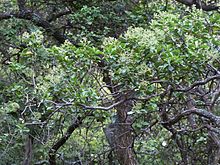
Leucadendron argenteum is an endangered plant species in the family Proteaceae, which is endemic to a small area of the Cape Peninsula, South Africa. Most grow in and around the city of Cape Town, but outlying populations exist near Somerset West (Silwerboomkloof), Paarl and Stellenbosch. It is a protected tree in South Africa.

Cussonia is a genus of plants of the family Araliaceae, which is native to the Afrotropics. It originated in Africa and has its center of distribution in South Africa and the Mascarene Islands. Due to their striking habit, they are a conspicuous and easily recognizable group of plants. Their genus name commemorates the botanist Pierre Cusson. The Afro-Malagasy and Asian Schefflera, and Afrotropical Seemannaralia genera are related taxa that share several of its morphological characteristics, among which the leaves borne on the end of branches, inflorescences carried on terminal branches or stems, and reduced leaf complexity in developing inflorescences.

Protea neriifolia, also known as the narrow-leaf sugarbush, oleander-leaved sugarbush, blue sugarbush, or the oleanderleaf protea, is a flowering plant in the genus Protea, which is endemic to South Africa.
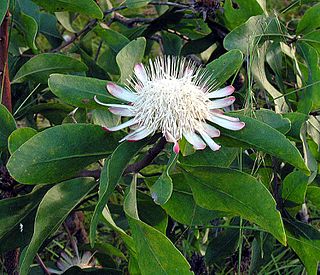
Protea gaguedi is a species of tree which belongs to the genus Protea.

Protea welwitschii is a species of shrub or small tree which belongs to the genus Protea, and which occurs in bushveld and different types of grassland.

Aloe marlothii is a large, single-stemmed Southern African aloe of rocky places and open flat country, occasionally growing up to 6 m tall.
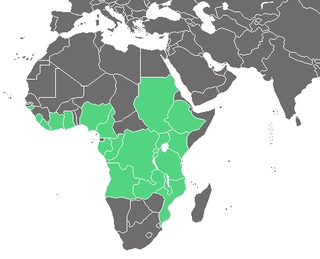
Bersama abyssinica is a species of medium-sized evergreen tree in the Francoaceae family. The leaves are pinnately divided with a strongly winged rachis. The inflorescence is a spike.
Nuxia glomerulata is a species of plant in the Stilbaceae family. It is endemic to South Africa, where it has a restricted range between Pretoria and Zeerust. It resembles Nuxia congesta but the leaves are more elliptic, leathery and glabrous. It is threatened by habitat loss.

Nuxia is a genus of plants in the family Stilbaceae described as a genus in 1791. It was formerly placed in the Loganiaceae and Buddlejaceae families.
Vatica congesta is a tree in the family Dipterocarpaceae, native to Borneo. The specific epithet congesta means "congested or combined", referring to the inflorescences.
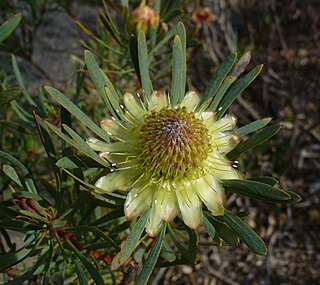
Protea scolymocephala, also known as the thistle protea or thistle sugarbush, is a flowering plant from the genus Protea native to South Africa.

Nuxia floribunda, the forest elder, forest nuxia or wild elder, is a species of tree in the Stilbaceae family, that is native to moist regions of southern Africa, East Africa and central tropical Africa.

Cassine peragua, also known as Cape saffron, bastard saffron and forest spoonwood, is a medium-sized tree with fragrant flowers, decorative fruits and a saffron-coloured trunk. It is indigenous to the Afro-montane forests of South Africa.
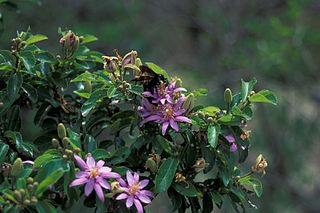
Grewia occidentalis, the crossberry, is a small, hardy, attractive tree indigenous to Southern Africa.

Croton gratissimus, is a tropical African shrub or small tree with corky bark, growing to 8 m and belonging to the family of Euphorbiaceae or spurges. Young twigs are slender and angular and covered in silver and rust-coloured scales.
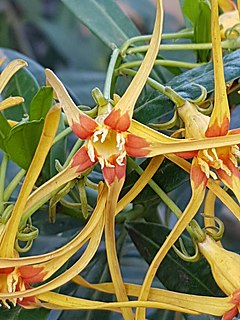
Strophanthus speciosus, commonly known as the forest poison rope, is a tree, shrub or woody climber which is native to southern Africa.
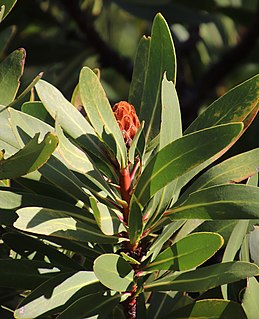
Protea rubropilosa, also known as the Transvaal sugarbush, escarpment sugarbush or Transvaal mountain sugarbush, is a flowering tree, that belongs to the genus Protea in the family Proteaceae. The plant only occurs in South Africa.

Protea burchellii, also known as Burchell's sugarbush, is a flowering shrub in the genus Protea, which is endemic to the southwestern Cape Region of South Africa.

Protea angustata, also known as the Kleinmond sugarbush, is a flowering shrub that belongs to the genus Protea. This plant is endemic to the south-west Cape Region of South Africa.

Dais is a genus of flowering plants in the family Thymelaeaceae. It is also part of the Gnidia subfamily, along with Gnidia, Drapetes, Kelleria, Pimelea, Struthiola, Lachnaea and Passerina, other genra of species). It is distributed between Tanzania to S. Africa, Madagascar. It is native to the countries of Eswatini, Lesotho, Madagascar, Malawi, Tanzania, Zimbabwe and it is also found within several Provinces of South Africa, such as Cape Provinces, Free State, KwaZulu-Natal and Northern Provinces.

